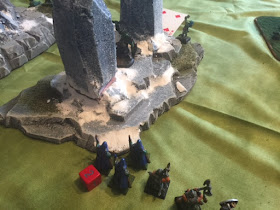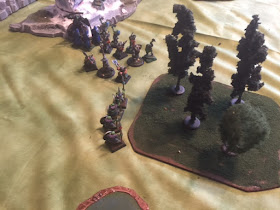Deep in the heart of the Darkened Wood, there lies a mystical place touched by unknown and mysterious magics. This place, the EverFrost, features three pillars of blue, frozen stone that stays frigid in spite of its placement in a lush and green forest. A force of Orcs and Goblins, led by Chieftain Urg and Shaman Grimnobb, ventured to the EverFrost on the eve of the Summer Solstice, when the contrast between the summer heat and the cold of the EverFrost pillars will heighten the power that Grimnobb can direct into a devious spell. Sensing a disturbance in the magical realm based on Grimnobb's dark designs, Dwarf mage Forgoth Greybeard and warrior Erik the Berserker lead a Dwarf warband that unites with a similarly-motivated band of Wood Elves, led by Chieftain Eofar and Swordmaster Turwyn, hoping to keep dark magics out of this world.
The goal of each warband is to have their mage standing on the EverFrost on the last turn of the game. Now, on to the tale of the tape:
 |
| The Elf-Dwarf coalition. Elves on the left, led by Chieftain Eofar and Swordmaster Turwyn. Dwarves on the right, led by mage Forgoth Greybeard and warrior Erik the Berserker. |
 |
| Orc and Goblin warband. Chieftain Urg (still a work in progress paint job) and Shaman Grimnobb in the center. |
 |
| Positions of the warbands at the game's outset. |
Orc and Goblin forces drew, on average, higher initiative and raced for the EverFrost pillars and into nearby woods to provide cover from notoriously accurate Elven arrows.
The fear of arrow fire was not irrational; Elven archers advanced and fired a long-range volley at the Goblins on the Green Horde left, connecting with one arrow. The Goblins spent a benny to soak this damage and keep the unit moving at the same pace. Another volley, this one aimed at Orcs, sent two arrows bouncing off of Orc shields.
 |
| Position of the forces at the end of Turn 1. The two minis out in front of the Elven line are their Chieftain and Swordmaster. |
The Green Horde largely led the way with initiative again. The Dwarven Mage fired a bolt of magic that hit an Orc but failed to wound.
The Orc shaman and his retinue moved forward to mount the rocks at the edge of the EverFrost, and the archer accompanying the mage fired an arrow at an opposite Dwarf that fell harmlessly to the earth.
The Elves and Dwarves continued to advance toward the EverFrost, with a number of arrows fired and failing to connect. The Elven Chieftain and Swordmaster were able to mount the rocks around the EverFrost.
 |
| View from the Elven left flank as their Chieftain and Swordmaster mount the rocks around the EverFrost. |
In the Green Horde initiative draws, two Jokers came up. On the resulting roll for associated random events, the Orc player designated a unit of Elven archers to suffer a -2 on all rolls this round. This would prove fortuitous.
The Elven Chieftain, the best archer on the field, moved to a position of advantage on the EverFrost rocks and fired an arrow into the Orc shaman, causing two wounds to the mage. He would recover one of them with a benny-driven Soak roll. This critical shot threatened the Orcs' chances for victory - with no mage standing on the EverFrost rocks at games' end, they would lose those victory points.
Both sides continued to move toward each other. The Orc chieftain moved to a place of partial cover between EverFrost pillars, and the temporarily hindered Elven archer unit took some shots at him. The -2 modifier meant the difference between him hits and misses.
 |
| The -2 modifier applied this turn to this Elven archer unit saved the Orc chieftain from being wounded. |
The Orc Shaman moved forward and cast a Blast spell with great success in spite of his lingering wound. He inflicted one wound on the Elven chieftain, and two on the Swordmaster. They both spent bennies to Soak wounds.
 |
| Blast marker of the Orc shaman's spell completely covered the Elven chieftain and swordmaster. |
 |
| Positions at the start of Turn 4. Flanking Goblins on either side of the Dwarf/Elf line, seeking to find a maneuver advantage. |
 |
| The Orc and Dwarf lines meet alongside the EverFrost. |
 |
| The Orcs come up snake eyes. And another 1. |
Turwyn, the Elven swordmaster, leapt forward and scored the first kill of the game. Bringing his greatsword crashing down on an Orc, he killed the beast instantly, and its lifeless body fell from rocks around the EverFrost.
 |
| Turwyn, Elven Swordmaster, vanquishes an Orc that falls dead to the earth next to the EverFrost. |
 |
| The closest any Goblin came to a successful flanking maneuver. |
 |
| The lead flanking Goblin falls dead, breaking the unit's momentum. |
 |
| Accurate Elven arrows repulse a parallel flanking attack on the other side of the field. |
The battle swung toward the Elves and Dwarves. All Orc and Goblin units that took casualties failed their Spirit checks (morale rolls) and started their flight from the field. The Orc and Goblin right flank, including their shaman, began to flee. The two Orcs engaged in combat with the Elven chieftain and swordmaster fell to sword blows as they tried to flee, and Elven arrows rained down on the Orc shaman as he fled, inflicting more wounds on him.
 |
| The Orc Shaman flees the field as his retinue broke, only to receive harrying arrow fire as he tries to leave the battle. |
 |
| The Orc line breaks and flees the field. |
1. The Savage Worlds Showdown system works well. I thought that the bennies (re-roll tokens) would be a nuisance, but the concept has grown on me. I can see how strategic use of them can really influence the course of a game.
2. Some models need to have stats adjusted. The Orcs had a d6 fighting skill, which made hits on some models all but impossible. Some or all need to be shifted to a d8 fighting skill.
3. The game was fun, and, with a few more under our belt the system should play pretty quickly.









